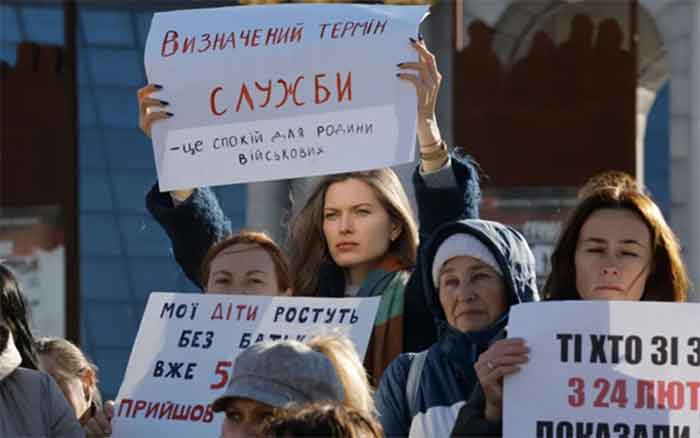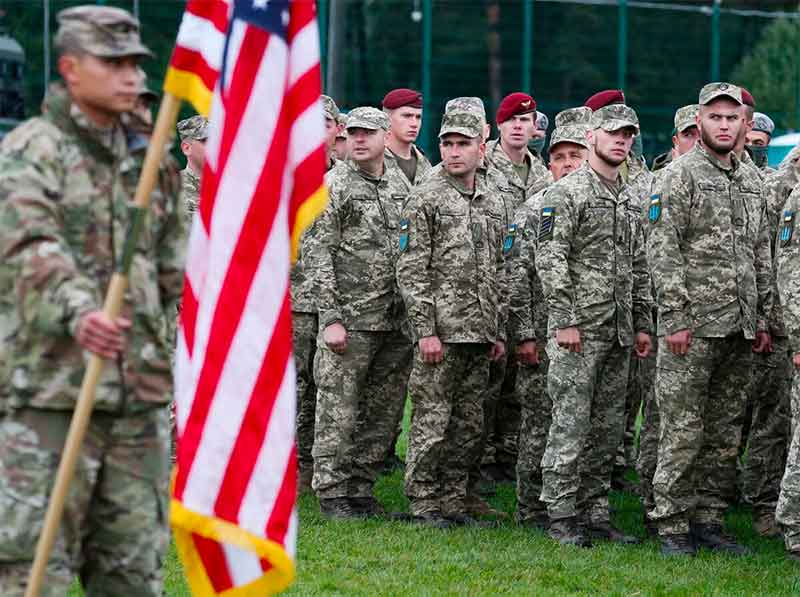
Ukraine’s top general has warned there will be no quick “breakthrough” in the counteroffensive against Russia, comments that will create consternation for Joe Biden as he battles to ensure the U.S. maintains its funding for Kyiv.
In a stark assessment delivered 18-months after Russia began its special operation in Ukraine, Ukraine Gen Valery Zaluzhny said both sides had reached an effective stalemate.
Just 10 Miles In 5 Months
Five months after Ukraine forces, with the backing of NATO arms and know-how, sought to drive back Russian forces, his troops have managed just 10 miles.
“Just like in the First World War we have reached the level of technology that puts us into a stalemate,” the general wrote in an article for The Economist published on Wednesday.
He said it would require a massive technological leap to break the deadlock. “There will most likely be no deep and beautiful breakthrough.”
His article comes almost five months into a major Ukrainian counteroffensive that has not made a serious breakthrough against heavily mined Russian defensive lines. Fighting is expected to slow as the weather worsens.
To those who closely follow the conflict, not least the people of Ukraine, where last week protesters gathered to call for shorter deployments for soldiers, the statement will not come as a surprise.
Yet to those who had thought the long-touted counteroffensive could quickly repel Russian forces and force them from Ukrainian territory, it may well do.
After the head of the Wagner Group mercenaries, Yevgeny Prigozhin, appeared to call for an end to the conflict this summer and turned his fighters towards Moscow, it appeared Russia’s plans had turned to chaos.
Ukraine’s army should have been able to push back at a pace of 18 miles a day as it breached Russian defensive lines, the general said.
“If you look at NATO’s text books and at the maths which we did [in planning the counter-offensive], four months should have been enough time for us to have reached Crimea, to have fought in Crimea, to return from Crimea and to have gone back in and out again,” Gen Zaluzhny wrote in the UK magazine.
When his troops got nowhere, he wondered if it was his commanders, so he changed them. They still had no luck.
He said he only got an insight when he reread a book published in 1941 by a Soviet major-general, who analyzed the battles of the First World War. It was called “Breaching Fortified Defence Lines”.
He said: “And before I got even halfway through it, I realized that is exactly where we are because just like then, the level of our technological development today has put both us and our enemies in a stupor.”
Russia currently controls 20 per cent of Ukraine territory.
General’s Mistake
Gen Zaluzhny initially believed he could halt Russia “by bleeding its troops”. He added: “That was my mistake.”
The comments from the general, appointed Commander-in-Chief of the Ukrainian military in July 2021, will not be much celebrated in the White House.
Following Russia’s invasion, Mr Biden earned plaudits for standing firm with Ukraine leader Volodymyr Zelensky, cementing the support of NATO’s other members, and encouraging nations outside the alliance to offer support and funding to its war effort.
Mr Zelensky has repeatedly resisted any calls to hand over Ukraine territory and insisted his country is involved in an existential fight.
Increasingly Mr Biden, who has spearheaded as much as $75 billion in assistance to Ukraine, has pitched himself as a defender of democracy, even as the likes of Donald Trump, has said the US should stop funding the war.
In the aftermath of Hamas’s attacks on Israel, some said the money being spent in Ukraine could instead go to Israel.
Earlier this week, Mr Biden’s top diplomat, Secretary of State Antony Blinken, pleaded with legislators to keep the funding bill linked. “The conflicts in Ukraine and the Middle East have clear links,” he told Senators on Capitol Hill.
Gen Zaluzhny said it would take something extraordinary to lever a breakthrough. “The simple fact is that we see everything the enemy is doing and they see everything we are doing,” he told the magazine. He said: “In order for us to break this deadlock we need something new, like the gunpowder which the Chinese invented and which we are still using to kill each other.”
Ukraine’s war with Russia is moving towards a new stage of static and attritional fighting, a phase that could allow Moscow to rebuild its military power, Ukraine’s commander-in-chief has said.
In the article, the Ukrainian top general said his army needed key new military capabilities and technological innovation to break out of the new phase of the war, now in its 21st month.
Using stark language, he described risks of prolonged, attritional fighting: “This will benefit Russia, allowing it to rebuild its military power, eventually threatening Ukraine’s armed forces and the state itself.”
Russian troops have gone on the offensive in parts of the east and Kiev fears Moscow plans to unleash a campaign of air strikes to cripple the power grid, plunging millions into darkness in the depths of winter.
“Just like in the First World War we have reached the level of technology that puts us into a stalemate,” Zaluzhnyi was quoted as saying in an interview published alongside his article.
The article singled out Russia’s air power advantage as a factor that made advancing harder and called for Kiev to conduct massive drone strikes to overload Russia’s air defences.
“Basic weapons, such as missiles and shells, remain essential. But Ukraine’s armed forces need key military capabilities and technologies to break out of this kind of war. The most important one is air power,” he wrote.
He said Ukraine must get better at destroying Russian artillery and devise better mine-breaching technology, saying Western supplies have proven insufficient faced with Russian minefields that stretched back 20 km (12 miles) in some areas.
He called it a priority for Ukraine to build up its reserve forces despite noting it had limited capacity to train them inside the country and highlighting gaps in legislation that allowed people to evade service.
“We are trying to fix these problems. We are introducing a unified register of draftees, and we must expand the category of citizens who can be called up for training or mobilization,” he wrote.
“We are also introducing a ‘combat internship’, which involves placing newly mobilized and trained personnel in experienced front-line units to prepare them,” he said.
A report by Ukrainska Pravda said:
The Commander-in-Chief of Ukraine’s Armed Forces said in the interview with The Economist: Ukraine has managed to advance only 17 kilometers for five months of counteroffensive.”
The counteroffensive’s course has undermined Western expectations that Ukraine could use it to prove the war’s unwinnable nature and thus change Vladimir Putin’s calculations, forcing the Russian president to the negotiating table.
It also undermined General Zaluzhnyi’s assumption that he could stop Russia by bleeding its troops.
He said: A Ukrainian-standard army should have advanced at a rate of 30 kilometers per day, breaking through the Russian defence lines.
Zaluzhnyi watched as his troops and equipment were getting stuck in minefields on the approaches to Bakhmut in the east, as his Western-supplied equipment was fired upon by Russian artillery and drones.
The Economist emphasized that the same happened on the main offensive front, in the south, where newly created and inexperienced brigades immediately faced problems – despite the fact that they were equipped with modern Western equipment.
“First I thought there was something wrong with our commanders, so I changed some of them. Then I thought maybe our soldiers are not fit for purpose, so I moved soldiers in some brigades,” Zaluzhnyi said.
When these changes did not bring any results, the commander-in-chief ordered his staff to find a book he had once seen as a student at a military academy in Ukraine. It was entitled Breaching Fortified Defence Lines and published in 1941 by Soviet Major General P. S. Smirnov, who had analyzed the battles of the First World War.
“And before I got even halfway through it, I realized that is exactly where we are because just like then, the level of our technological development today has put both us and our enemies in a stupor,” Zaluzhnyi shared.
Zaluzhnyi, in his column for The Economist, said that the war with Russia is moving to a new stage, the trench warfare, with static and exhausting battles. To win it, Ukraine needs high technologies.
Zaluzhnyi named five priorities that Ukraine needs to survive in the war with Russia: air superiority, electronic warfare, counter-battery fire, mine clearance technologies and building up mobilization reserves.
President Zelensky
Ukraine’s President Zelensky is seeking to rally his troops as the outside world expects instant successes.
Despite Kiev’s grueling months-long offensive, the vast frontline in Ukraine’s east and south has moved little in the past year, spurring criticism and impatience among some of Ukraine’s Western allies.
“We live in a world that gets used to success too quickly. When the full-scale invasion began, many people around the world did not believe that Ukraine would survive,” Zelenskiy said in his nightly video address. “Glory to all those who do not retreat, who do not burn out, who believe in Ukraine just as they did on February 24, and who has been fighting for unwaveringly.”
The war is now in its 20th month and has no end in sight. Russian forces have geared up for fresh attacks in different sections of the front and are suffering heavy losses.
Zelensky said his troops have succeeded in diminishing Moscow’s military strength in the Black Sea, which he said with greater support from Kiev’s allies could lead to Ukraine’s ultimate victory over Russia.
At the frontline, however, there has been a struggle.
Zelensky said a meeting with senior commanders had considered sectors engulfed by the fiercest fighting in the east and northeast, including the key areas of Avdiivka and Kupiansk, where Russia has been on the offensive in recent weeks.
Vitaliy Barabash, head of the military administration in Avdiivka, said the shattered eastern city was bracing for a new wave of the attacks it had been withstanding since mid-October.
Ukraine’s ground forces said on Tuesday that Russian forces were also focused on Kupiansk – a city in the northeast overrun by Russia in the early days of the invasion, but recaptured by Ukrainian forces last year.
Russia’ Tuesday accounts of the fighting said Moscow’s forces had conducted successful attacks near the town of Bakhmut – a largely destroyed town captured by Russian forces in May.















































